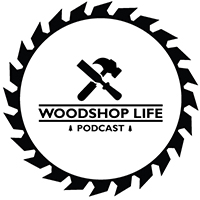Support us on Patreon: https://www.patreon.com/woodshoplife
Sean
1) Second question: This question is for Sean, mostly. I’m getting ready to make a blanket chest with frame-and-panel front, sides, and back, out of cherry and walnut, but the recipient wants the wood from a single source. So for the first time I’ll be making the internal panels out of resawn cherry rather than plywood. I remember that you said you had a problem with trapped hardwood panels in a set of end tables (I think?) you made for your parents a while back. I can’t quite find the episode, but I was wondering what how you would go about doing hardwood panels for a frame-and-panel cabinet now — what would you do differently to keep the wood movement under control? Any tips for making thinner, 1/2 inch panels in general? Thank you all — I love supporting such a great conversation.
Adam
2) Hi guys! Another quick question – I’m making a small table and the base will be ash, ebonized with India ink. What would be a good choice for topcoat over the India ink? I was thinking of using a water-based poly, but it seems to “reactivate” the ink. Maybe shellac would be fine? Thanks!!
Dan
Huy
1)I was recently setting up to rip 60 facets to create a hexagonal column that is 1.5 inches across the flats. I have a right tilting arbor on my table saw. With my rip fence on the right side of the blade the blade tilts toward the fence. This would mean the top facet would be cut with that geometry and the the work piece would be pinched against the fence. I could move the fence to the other side which would allow me to cut the bottom facet and the work piece would not be pinched against the fence. I have never ripped on the left side of my blade. I ultimately decided to do this on the bandsaw which worked fine.
This brought up the question as to which is the preferred tilt direction for the table saw? Do we need one of each or is one direction more useful than the other. I would like to know your thoughts about this.
Thanks,
Dave Pollatta
Ontario, New York
2) I rarely hear mention of woods like Cumaru and Ipe for exterior use in articles, podcast or see it used by woodworkers I follow on social media, is there a reason? Weight and hardness Im sure factor into the decision as they can be difficult to work, but are they still worth a mention?
Guy
1) Question: I prefer 3/16” solid wood edge banding over the veneer, have to ask your opinion?
Harder to install, but better I think. Glenn
2) Hey guys! First off, I have to say, glad to have fellow metalheads in the woodworking community! I wanted to follow up on something good ole’ Guy said a while back about how he makes his own Danish Oil.
Poly, BLO, and…. Naphtha? The Naphtha threw me for a loop seeing as how every YouTube video says to use Mineral Spirits. Well, I gave it a side-by-side test and yep, I liked Naphtha better! Good call!
So, my question is, what other chemical tricks do you guys have up your sleeve? Anything out of the ordinary novice woodworkers may not know? I pretty much have one of each and only a little used from each. So I’m looking for inspiration!
And lastly, we all hear the combustible chemicals need to be stored in a metal cabinet. Why? It’d have to cram in next to all my other wooden shop cabinets anyway.
Keep up the great work!
Paul
